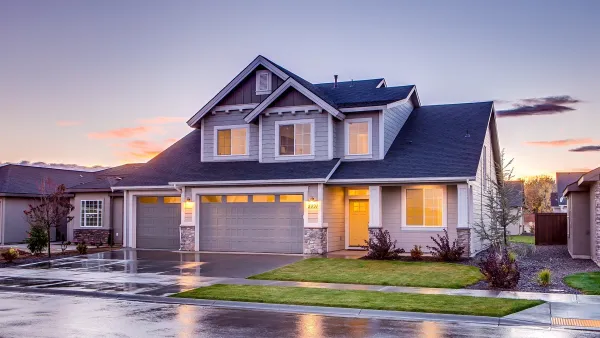As part of its "Future Tense" initiative with the New America Foundation, Slate is exploring the concept of resilience. In this article, Patrick Doherty makes the case for improving America's resilience by reconsidering suburban development.
Doherty argues that the world is facing an "existential challenge" of unsustainability, and that one of the best ways to address it is to face the fact that the postwar suburban housing model no longer works, is incommensurate with America's demographic changes, and is no longer considered desirable by a large majority of potential homeowners. He writes,
"There is a great demographic change happening in America. Baby boomers and millennials are changing the definition of the American dream and, in the process, have created a pool of demand for housing nearly three times as large as what existed after World War II. The trick is, it's not for the homes that builders are building.
Boomers and millennials, the two largest demographic groups in the country, are converging in a time-of-life moment where what they want is smaller homes on smaller lots in walkable, service-rich, transit-oriented communities. Boomers, who have just started turning 65, are empty-nesting and downsizing. But they are going to have to work much later into what they thought would be their retirement, and they fear the fate of their parents, who had their car keys taken away and ended up in the nursing home. Millennials are in the process of getting married and having kids, and according to market surveys, 77 percent simply don't ever want to go back to the ‘burbs.
At the end of the day, traditional subdivisions are isolating and expensive, while millennials are increasingly connected, are more into tech than cars, and are seeing their economic future more like their grandparents'-full of hard work and living on a budget."
FULL STORY: Death to the McMansion

Analysis: Cybertruck Fatality Rate Far Exceeds That of Ford Pinto
The Tesla Cybertruck was recalled seven times last year.

National Parks Layoffs Will Cause Communities to Lose Billions
Thousands of essential park workers were laid off this week, just before the busy spring break season.

Retro-silient?: America’s First “Eco-burb,” The Woodlands Turns 50
A master-planned community north of Houston offers lessons on green infrastructure and resilient design, but falls short of its founder’s lofty affordability and walkability goals.

Test News Post 1
This is a summary

Analysis: Cybertruck Fatality Rate Far Exceeds That of Ford Pinto
The Tesla Cybertruck was recalled seven times last year.

Test News Headline 46
Test for the image on the front page.
Urban Design for Planners 1: Software Tools
This six-course series explores essential urban design concepts using open source software and equips planners with the tools they need to participate fully in the urban design process.
Planning for Universal Design
Learn the tools for implementing Universal Design in planning regulations.
EMC Planning Group, Inc.
Planetizen
Planetizen
Mpact (formerly Rail~Volution)
Great Falls Development Authority, Inc.
HUDs Office of Policy Development and Research
NYU Wagner Graduate School of Public Service




























